Description
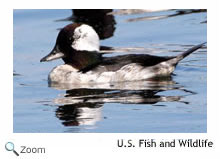 The bufflehead is the smallest diving duck in North America. It is 11-15 inches in length with a wingspan of 22 inches and usually weighs less than a pound. The male has a white chest, belly, and sides. He has a black back and a black head with a
greenish and purplish shine. He has
a large white patch that covers the back half of its head. The female has a light brownish-black back, a gray belly and sides, and a small white patch on her cheek. Both the male and female have a short neck and a small, narrow gray bill. The bufflehead was first called the buffalo head because of the male's large domed head! The bufflehead is the smallest diving duck in North America. It is 11-15 inches in length with a wingspan of 22 inches and usually weighs less than a pound. The male has a white chest, belly, and sides. He has a black back and a black head with a
greenish and purplish shine. He has
a large white patch that covers the back half of its head. The female has a light brownish-black back, a gray belly and sides, and a small white patch on her cheek. Both the male and female have a short neck and a small, narrow gray bill. The bufflehead was first called the buffalo head because of the male's large domed head!
Range 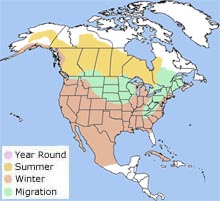 During breeding season, the bufflehead is found from Alaska east to Quebec, Canada and south in the mountains from Washington to Montana. It winters from Alaska east to Nova Scotia, Canada and south throughout the most of the
continental
United States south to Mexico. During breeding season, the bufflehead is found from Alaska east to Quebec, Canada and south in the mountains from Washington to Montana. It winters from Alaska east to Nova Scotia, Canada and south throughout the most of the
continental
United States south to Mexico.
Habitat
The bufflehead often uses the abandoned nests of northern flickers. During breeding season, it is found in freshwater ponds and small lakes with poplar or aspen stands or
coniferous forests
with poplar or aspen trees inhabited by northern flickers. In the winter, it is found in shallow saltwater bays and estuaries, in lakes, and in rivers.
|
|
Diet
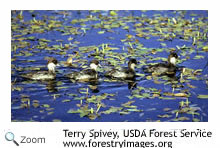 The bufflehead is a diving duck. It dives for food like
insects, crustaceans, mollusks, and seeds.
It's
prey is swallowed while the bufflehead is under water.
It feeds in small flocks of around ten birds. One bufflehead usually keeps watch while the others are diving for food. The bufflehead is a diving duck. It dives for food like
insects, crustaceans, mollusks, and seeds.
It's
prey is swallowed while the bufflehead is under water.
It feeds in small flocks of around ten birds. One bufflehead usually keeps watch while the others are diving for food.
Life Cycle 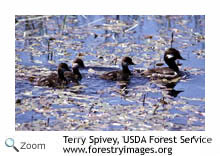 The female bufflehead usually returns to the area where she was born in the early spring to breed. The male only mates with one female, and the same pair may mate for many years. The male tries to attract a female by bobbing and shaking his head and by flying over the female. The male may chase other males away from a lake or pond that he has claimed as his territory. The female bufflehead usually returns to the area where she was born in the early spring to breed. The male only mates with one female, and the same pair may mate for many years. The male tries to attract a female by bobbing and shaking his head and by flying over the female. The male may chase other males away from a lake or pond that he has claimed as his territory.
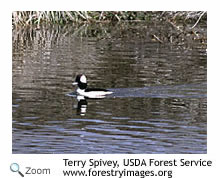 The female lays 6-11 ivory-colored eggs at a rate of one egg per day. She usually lays her eggs in a tree cavity close to two feet above the ground. The bufflehead usually uses a tree cavity abandoned by a northern flicker. The female incubates the eggs and the chicks hatch in 25-30 days. The male leaves the female once she begins to incubate the eggs. When the chicks are a few days old, the female hops down from the nest and calls to the chicks to encourage them to hop down form the nest. Once they hop down, she leads them to water. The female lays 6-11 ivory-colored eggs at a rate of one egg per day. She usually lays her eggs in a tree cavity close to two feet above the ground. The bufflehead usually uses a tree cavity abandoned by a northern flicker. The female incubates the eggs and the chicks hatch in 25-30 days. The male leaves the female once she begins to incubate the eggs. When the chicks are a few days old, the female hops down from the nest and calls to the chicks to encourage them to hop down form the nest. Once they hop down, she leads them to water.
Behavior
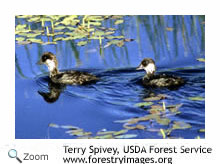 The bufflehead is awkward on land because its feet are set back on its body, but it is a good swimmer and a fast flier! The bufflehead
runs on the water to work up enough speed to launch itself into flight. When in flight, it flies close to the water. The bufflehead is awkward on land because its feet are set back on its body, but it is a good swimmer and a fast flier! The bufflehead
runs on the water to work up enough speed to launch itself into flight. When in flight, it flies close to the water.
|

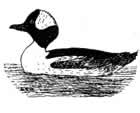

 During breeding season, the bufflehead is found from Alaska east to Quebec, Canada and south in the mountains from Washington to Montana. It winters from Alaska east to Nova Scotia, Canada and south throughout the most of the
continental
United States south to Mexico.
During breeding season, the bufflehead is found from Alaska east to Quebec, Canada and south in the mountains from Washington to Montana. It winters from Alaska east to Nova Scotia, Canada and south throughout the most of the
continental
United States south to Mexico.



